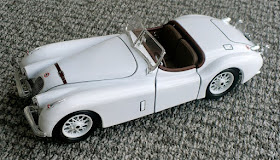




Here are some images of Bburrago's 1/24 scale Jaguar XK 120
From Wikipedia"
The XK120 was launched in roadster form at the 1948 London Motor Show as a testbed and show car for the new Jaguar XK engine. It caused a sensation, which persuaded Jaguar founder and design boss William Lyons to put it into production.
The "120" in its name referred to its 120 mph (193 km/h) top speed (faster with the windscreen removed), which made the XK120 the world's fastest standard production car at the time of its launch.
It was available in two 'open' versions — first as the roadster (designated OTS, for open two-seater, in America), then, also as a drophead coupé, DHC, from 1953 — and as a closed, or "fixed-head" coupé (FHC) from 1951. The DHC was a more deluxe open model, featuring the beautiful wood dashboard and wood accent veneers on the interior as found on the FHC.
The roadster version was successful in racing.
The first 242 cars, all roadsters hand-built between late 1948 and early 1950, had aluminium bodies on ash frames. To meet demand it was necessary for the mass-production versions, beginning with the 1950 model year, to have pressed-steel bodies. They retained aluminium doors, bonnet, and boot lid.
With alloy cylinder head and twin side-draft SU carburetors, the dual overhead-cam 3.4 L straight-6 XK engine was comparatively advanced for a mass-produced unit of the time. With standard 8:1 compression ratio it developed 160 bhp (119 kW). A 7:1 low compression version was also available to cope with low quality fuel. This same basic design of the XK engine, later modified into 3.8L and 4.2L versions, survived into the late 1980s.
All XK120s had independent torsion bar front suspension, semi-elliptic leaf springs at the rear, recirculating-ball steering, telescopically adjustable steering column, and all-round drum brakes that were prone to fade. Some cars were fitted with Alfin brake drums to help overcome this brake fade.
The roadster's lightweight canvas top and detachable sidescreens stowed out of sight behind the seats, and its barchetta-style doors had no external handles; instead there was an interior pull-cord which was accessible through a flap in the sidescreens when the weather equipment was in place. The windscreen could be removed for aeroscreens to be fitted.
The drophead coupé [DHC] offered a padded, lined canvas top, which folded onto the rear deck behind the seats when retracted, and roll-up windows with opening quarter-lites. The flat glass two-piece windscreen was integral as a body-colored steel frame. Dashboards and door-caps in both the closed steel top coupe' [fixed-head, FHC] and DHC were wood-veneered, whereas the spartan roadster's were leather-trimmed. All models had removable spats ("fender skirts" in America) covering the rear wheel arches, which enhanced the streamlined look. On cars fitted with optional centre-lock wire wheels (available from 1951), the spats were omitted as they gave insufficient clearance for the two-eared Rudge-Whitworth chromed knockoff hubs.
In addition to wire wheels, upgrades on the Special Equipment, or SE, version (called the M version in the United States) included increased power, stiffer suspension and dual exhaust system.
All models of these early Jaguars are highly sought by collectors around the globe.
I would love to have one of these babies...(full size please!)
ReplyDeleteLOL you and me both.
ReplyDelete